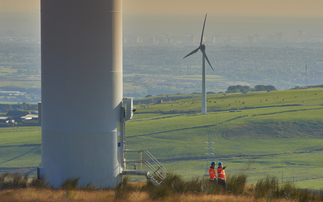Yvo de Boer says the latest UN text should deliver an industry-focused approach to tackling climate change
What will the Paris climate agreement do for business? Will it put a price on carbon? Will it incentivise business action? Will it drive innovation? Will it give business a place at the table for a discussion on solutions basically only business can deliver? Will it open new markets, forge new coalitions, create fresh opportunities?
There are all questions that are (or should be) on the minds of business people around the world. Past experience will probably quickly prompt them to answer "no" on all points. Previous climate negotiations have been a mainly closed intergovernmental process dealing with issues in a political context and at a level of abstraction hardly relevant to the average business person. But in Paris that could change.
Paris can change the rules of engagement. Paris can narrow the focus on specific sectors, technologies and the investments needed to drive change in those specific areas. I suppose my question is, if some successful sector based approaches of the past can make their way into the climate process of the future. If that would be useful, then the "hooks" on which to hang a more industry focused approach in the Paris language must be found.
More than 20 years ago, going into the Kyoto Protocol negotiations, the European Union and some others favoured working towards a regime that would focus on policies and measures. PAM's as they were called in the negotiating lingo. The reason was quite simply that Europe had successfully negotiated standards for everything from toothbrushes to large combustion plants with industry and with (member) countries that were almost as divers in their development as many of the UNFCCC Parties today.
New member states had seen their arcane industries collapse together with the Berlin Wall, in Romania there were more donkey carts on the streets than cars, while Northern Europe bathed in wealth and sophistication. In spite of these differences a very diverse group did come together and set common standards - not always immediately the best ones - and sometimes with transition phases. Not ideal, but it worked, there was progress and industry was at the table.
In the subsequent negotiations the US and some others fought hard for targets and timetables, which is what we got. The PAM's were relegated to an annex and a vague Article in the Kyoto Protocol offers two or more Parties that want to do so, the opportunity to work together on PAM's with support of the Secretariat.
Australia almost invoked the clause, but that aside it remained dormant and no real discussion on common approaches took place during the subsequent negotiations.
Occasionally, you did hear someone sigh how good life is under the Montreal Protocol, where technological solutions have been identified and a fund created to help developing countries to deploy them. The wishful holding this up as a good example for the climate community to follow, were quickly told that the world of climate is too complex for a Montreal-style approach to work and that is general where it ended.
Today, Paris could offer another bite at the cherry. After all, once the INDCs are enshrined, the process should be all about implementation. Doing real things on the ground. And there, looking at specific sectors, technologies and how to finance them could become a very productive approach. So does the Paris language offer opportunities to focus the post-Paris implementation phase on different sectors, their mitigation (or adaptation) potential, the technologies available to realise this potential and the financial mechanisms already available or to be created in order to drive investments?
There are "hooks galore" in the Paris language to lay the basis for a sector-oriented industry engagement policy options, technology and finance.
Paragraph 8 of Article 3 of the draft Agreement offers countries the opportunity to jointly implement their efforts.
Article 7 calls for strengthened cooperation on technology development and deployment, while stressing the need to remove barriers.
Paragraph 1 of Article 15 could provide the basis for the creation of a Subsidiary body (or other institutional arrangement) that would serve as the platform to undertake the work this article suggests.
Paragraph 50 (b) of the draft decision recognizes the need to attract private sector investments.
Paragraph 69 (a) encourages the active engagement of non-Party stakeholders.
Paragraph 70 requests the Secretariat to organize technical expert meetings.
Taken together these elements can lay the foundation for a post-Paris process that focuses on industry sectors, conducive policy change, technological options and financial solutions - a process in which industry can have a central role. The focus would very much be on what can be done to achieve maximum result in practical ways. These kinds of initiatives are essential to ensure that national actions are implemented a way that encourages countries to take climate action to the next level of ambition when the Paris outcome is reviewed in five years' time.
This article is part of BusinessGreen's Road to Paris hub, hosted in association with PwC








